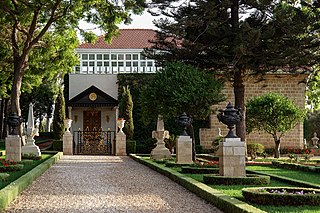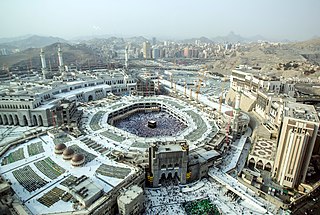
Ummah is an Arabic word meaning "community". It is distinguished from shaʻb, which means a nation with common ancestry or geography. Thus, it can be said to be a supra-national community with a common history.

In the Baháʼí Faith the Qiblih is the location to which Baháʼís face when saying their daily obligatory prayers. The Qiblih is fixed at the Shrine of Baháʼu'lláh, near Acre, in present-day Israel; approximately at 32°56′37″N35°5′31″E.

The qibla is the direction towards the Kaaba in the Sacred Mosque in Mecca, which is used by Muslims in various religious contexts, particularly the direction of prayer for the salah. In Islam, the Kaaba is believed to be a sacred site built by prophets Ibrahim and Ismail, and that its use as the qibla was ordained by Allah in several verses of the Quran revealed to Muhammad in the second Hijri year. Prior to this revelation, Muhammad and his followers in Medina faced Jerusalem for prayers. Most mosques contain a mihrab that indicates the direction of the qibla.

The Black Stone is a rock set into the eastern corner of the Kaaba, the ancient building in the center of the Grand Mosque in Mecca, Saudi Arabia. It is revered by Muslims as an Islamic relic which, according to Muslim tradition, dates back to the time of Adam and Eve.

Bakkah, is a place mentioned in surah 3, ayah 96 of the Qur'an, a verse sometimes translated as: "Surely the first House ˹of worship˺ established for humanity is the one at Bakkah—a blessed sanctuary and a guide for ˹all˺ people."

Mihrab is a niche in the wall of a mosque that indicates the qibla, the direction of the Kaaba in Mecca towards which Muslims should face when praying. The wall in which a mihrab appears is thus the "qibla wall".

A qibla (qiblah) compass is a modified compass used by Muslims to indicate the direction to face to perform prayers. In Islam, this direction is called qibla, and points towards the city of Mecca and specifically to the Kaaba. While the compass, like any other compass, points north, the direction of prayer is indicated by marks on the perimeter of the dial, corresponding to different cities, or by a second pointer set by the user according to their own location. To determine the proper direction, one has to know with some precision both the longitude and latitude of one's own location and those of Mecca, the city toward which one must face. Once that is determined, the values are applied to a spherical triangle, and the angle from the local meridian to the required direction of Mecca can be determined.

Sankoré Madrasa is one of three ancient centers of learning located in Timbuktu, Mali. It is believed to be established by Mansa Musa, who was the ruler of the Mali Empire, though the Sankoré mosque itself was founded by an unknown Malinke patron. The three mosques of Sankoré: Sankoré, Djinguereber, and Sidi Yahya comprise the University of Timbuktu. The madrasa went through multiple periods of patronage and renovation under both the Mali Empire and the Songhai Empire until the Battle of Tondibi in 1591 led to its looting. Madrasa (مدرسة) means school/university in Arabic and also in other languages that have been influenced by Islam.

The Kutubiyya Mosque or Koutoubia Mosque is the largest mosque in Marrakesh, Morocco. It is located in the southwest medina quarter of Marrakesh, near the Jemaa el-Fnaa market place, and is flanked by large gardens.
Occasions or circumstances of revelation names the historical context in which Quranic verses were revealed from the perspective of traditional Islam. Though of some use in reconstructing the Qur'an's historicity, asbāb is by nature an exegetical rather than a historiographical genre, and as such usually associates the verses it explicates with general situations rather than specific events. The study of asbāb al-nuzūl is part of the study of Tafsir.

The city of Jerusalem is sacred to many religious traditions, including the Abrahamic religions of Judaism, Christianity and Islam which consider it a holy city. Some of the most sacred places for each of these religions are found in Jerusalem, most prominently, the Temple Mount/Haram Al-Sharif.

The holiest sites in Islam are predominantly located in the Arabian Peninsula and the Levant. While the significance of most places typically varies depending on the Islamic sect, there is a consensus across all mainstream branches of the religion that affirms three cities as having the highest degree of holiness, in descending order: Mecca, Medina, and Jerusalem. Mecca's Al-Masjid al-Haram, Al-Masjid an-Nabawi in Medina, and Al-Masjid al-Aqsa in Jerusalem are all revered by Muslims as sites of great importance.
The Masjid al-Qiblatayn, also spelt Masjid al-Qiblatain, is a mosque in Medina believed by Muslims to be the place where the final Islamic prophet, Muhammad, received the command to change the Qibla from Jerusalem to Mecca. The mosque was built by Sawad ibn Ghanam ibn Ka'ab during the year 2 AH and is one of the few mosques in the world to have contained two mihrabs in different directions.

The Kaaba, also spelled Ka'ba, Ka'bah or Kabah, sometimes referred to as al-Ka'ba al-Musharrafa, is a stone building at the center of Islam's most important mosque and holiest site, the Masjid al-Haram in Mecca, Saudi Arabia. It is considered by Muslims to be the Bayt Allah and is the qibla for Muslims around the world. The current structure was built after the original building was damaged by fire during the siege of Mecca by Umayyads in 683.

Both Sunni Muslims and Shia Muslims agree on the three Holiest sites in Islam being, respectively, the Masjid al-Haram, in Mecca; the Al-Masjid an-Nabawi, in Medina; and Al-Masjid al-Aqsa, in Jerusalem.

Masjid al-Haram, also known as the Grand Mosque or the Great Mosque of Mecca, is a mosque enclosing the vicinity of the Kaaba in Mecca, in the Mecca Province of Saudi Arabia. It is a site of pilgrimage in the Hajj, which every Muslim must do at least once in their lives if able, and is also the main phase for the ʿUmrah, the lesser pilgrimage that can be undertaken any time of the year. The rites of both pilgrimages include circumambulating the Kaaba within the mosque. The Great Mosque includes other important significant sites, including the Black Stone, the Zamzam Well, Maqam Ibrahim, and the hills of Safa and Marwa.

Twice every year, the Sun culminates at the zenith of the Kaaba in Mecca, the holiest site in Islam, at local solar noon, allowing the qibla to be ascertained in other parts of the world by observing the shadows cast by vertical objects. This phenomenon occurs at 12:18 Saudi Arabia Standard Time on 27 or 28 May, and at 12:27 SAST on 15 or 16 July. At these times, the sun appears in the direction of Mecca, and shadows cast by vertical objects determine the qibla. At two other moments in the year, the sun passes through the nadir of the Kaaba, casting shadows that point in the opposite direction, and thus also determine the qibla. These occur on 12, 13, or 14 January at 00:30 SAST, and 28 or 29 November at 00:09 SAST.
Prayer in a certain direction is characteristic of many world religions, such as Judaism, Christianity, Islam and the Bahá'í Faith.

A sitara or sitarah is an ornamental curtain used in the sacred sites of Islam. A sitara forms part of the kiswah, the cloth covering of the Kaaba in Mecca. Another sitara adorns the Prophet's Tomb in the Al-Masjid an-Nabawi mosque in Medina. These textiles bear embroidered inscriptions of verses from the Quran and other significant texts. Sitaras have been created annually since the 16th century as part of a set of textiles sent to Mecca. The tradition is that the textiles are provided by the ruler responsible for the holy sites. In different eras, this has meant the Mamluk Sultans, the Sultans of the Ottoman Empire, and presently the rulers of Saudi Arabia. The construction of the sitaras is both an act of religious devotion and a demonstration of the wealth of the rulers who commission them.















